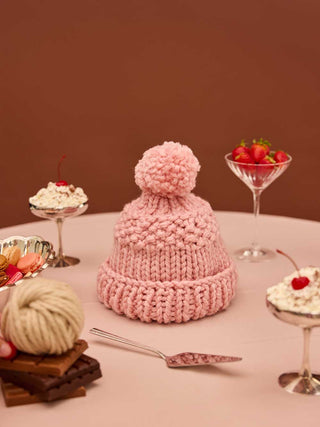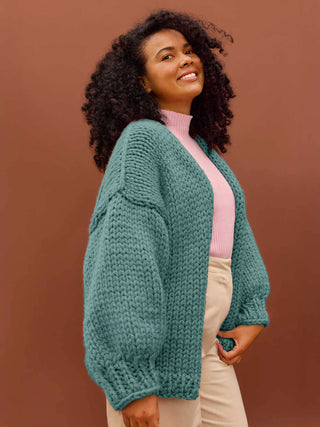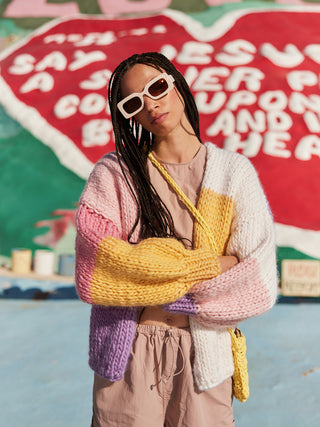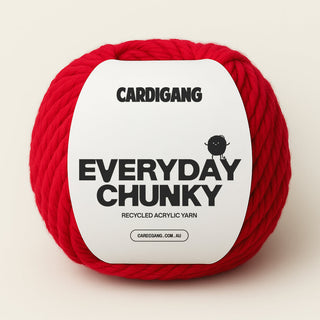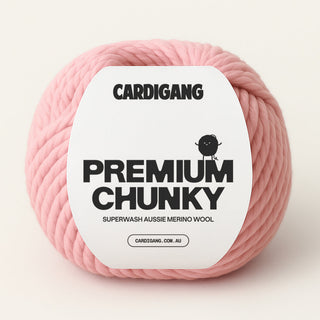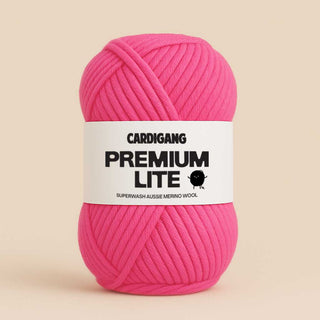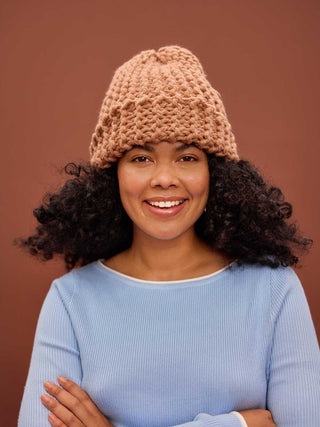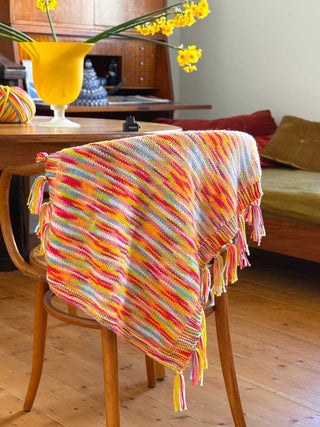A step by step guide to knitting the gorgeous Megan Vest.
Ever gotten half way through a project and thought “Hang on, am I even doing this right?”
We have 🙋♀️
That’s why we’ve created these step by step overviews to help guide you through the knitting process. At each stage we’ll show you how each section of your piece should look, and at the end, how to sew it all together. Voilà!
THE BASICS
If you're a total knitting newbie - WELCOME! 🧶 Learning to knit can feel like learning code. We've stripped away the complicated jargon and tried to keep things really simple.
Before we get started on the pattern it’s a good idea to learn the basic stitches you’ll need to complete your masterpiece. You can use the yarn that came in your kit to practice with, just be gentle with the yarn - it’s super fine so will break if it’s worked too hard or too many times. We’ve put the below video together to cover the basics. Learn how to cast on, do a knit stitch, a purl stitch and put them together to create a 1x1 rib stitch, lastly we learn casting off. Once you've got these mastered you'll find this pattern is a cinch!
💭 For more detailed videos of each technique, head down a little further where we've got specific videos for each stitch type.
🏅🧶 You got this! ⚡️💪
Remember learning a new skill can be a little hard at first and you’re bound to find yourself making some mistakes along the way. But as with learning anything, your brain and your hands slowly start to get the hang of it, muscle memory is created, and soon the thing you found tricky/daunting/scary is like second nature!
TEST YOUR TENSION
It’s a good idea to check that the tension (how tightly or loosely your knitting is) is in line with what we need. We knit a “tension swatch” to make sure the tension is juuuust right. It's a bit like goldilocks, if the tension is too tight, your jumper will be too small, and if it's too loose it may not hold it's shape and might be too big.
If done correctly, your 10x10cm knitted swatch should be 7 stitches high and 9 rows wide. To test this, jump on your needles, cast on around 12 stitches, then knit in stockinette stitch (row 1 knit, row 2 purl) for around 10 rows. Then get a measuring tape and measure out 10x10cm and count your stitches and rows to make sure you're knitting at the correct tension.
ONTO THE MEGAN!
SIZING
You can knit the Megan in size 1, 2 or 3. Your pattern is read like this: 1 (2, 3).
MEASUREMENTS
Lying flat your finished piece will measure:
📏 Size 1: 50cm w x 46cm h
📏 Size 2: 53cm w x 50cm h
📏 Size 3: 56cm w x 54cm h
WHAT YOU’LL NEED
Your kit comes with everything you need to knit your masterpiece. To knit Megan you’ll use;
-
10mm circular needles - we use these for the rib at the bottom and around the neckline
-
15mm circular needles - these are to knit the body of the top
-
2-3 x balls of our chunky merino wool
-
Darning needle - this is used to sew your piece together and weave in loose ends when you finish knitting
THE TECHNIQUES YOU’LL MASTER
CASTING ON
Casting on is the first step in any project. It's the term we use for getting the wool onto our needles! We recommend using the two-needle technique as it's one of the simplest methods. Two-needle cast on uses your two needles (surprise!), starting with a slip knot on your left needle, each stitch is knitted to form a new loop and this loop is then added to your left needle. You repeat until you’ve made the desired number of stitches.
💭 Casting on, like many things in knitting, can be done in a number of ways - our suggestion is a simple technique but you can pick any that’s right for you.
KNIT STITCH
This handy little stitch makes up the backbone of most knitting patterns. Each knit stitch looks like a little ‘v’.
PURL STITCH
The second most common stitch, purl stitches look like little bumps (or purls!). You knit a knit stitch with your yarn tail at the back of your work and your needle going into the back of the stitch, the purl is the opposite, so your yarn tail is at the front of your work and your needle goes into the front of the stitch.
STOCKINETTE STITCH
Stockinette Stitch (or stocking stitch) is a basic stitch that most knitting patterns often don't explain! When knitting flat, you create stockinette stitch by knitting one row and purling the next. This means all of your knit stitches (the little Vs) will be on the right side of your jumper.
💭 We go into a stockinette stitch once we stop knitting in the round.
SEED STITCH
Seed Stitch is a common, easy stitch pattern in knitting. It is made by alternating knit stitches and purl stitches within a row and between rows. It is called seed stitch because the stitches create little bumps that may look like seeds. Seed stitch is identical on both sides and lies flat.
RIB STITCH
1x1 rib stitch is a textured pattern usually used on the cuffs and necks of jumpers. It’s made by alternating knit and purl stitches in the same row, then knitting the same stitch sequence in the next row. When doing your rib stitch it’s important to make sure your yarn is on the correct side of your needles (at the back for knit stitches and at the front for purl stitches). To see rib stitch in action watch our "Master The Basics" video above.
KNITTING IN THE ROUND
Knitting in the round is where we use our circular needles and knit continuously in loops, rather than back and forth in rows (like a lot of beginner patterns do). Now don't worry! It's not anywhere near as hard as it sounds. When knitting in the round, you're always knitting on the "front" side of your work so you don't need to turn the piece to knit on the "back" side. Plus, you don't need to sew your pieces together at the end!
CASTING OFF
To cast off, knit two stitches then slip the first stitch on your right needle back over the second stitch and off the needle. You’ll have one stitch left on your right needle. Knit another stitch so you’ve got two stitches on your right needle and then slip the first stitch off. Continue to the end of the row. When you’ve got the last stitch on your right needle, cut the yarn and thread this through the final stitch to secure. To see casting off in action watch our "Master The Basics" video above.
OKAY, LET’S KNIT UP A STORM!

Step 1:
Cast on the required number of stitches using your 10mm circular needles.
Step 2:
Once you've cast on the right number of stitches you move on to the rib. Knit the rib following the instructions in your pattern. Remember to create a rib we knit 1 stitch, then purl the next. Make sure you’re moving your yarn tail from the back to the front of our stitch to ensure the stitch is executed correctly.
JOINING YOUR STITCHES
When we knit in the round it’s important to make sure that you connect your stitches in a loop when you knit your first row.
💭 Make sure you use a stitch marker to keep track of the number of rows/loops you’ve knitted. A stitch marker can be anything round; a ring, hair tie or a spare piece of yarn.
Step 3:
Next, we move onto using our 15mm needles and into stockinette stitch. To switch to a different size needle we just hold the new needle in our right hand and knit onto it.
You'll knit the allocated number of rows of stockinette stitch.
Step 4:
Next we're going to do some rows of seed stitch. Seed stitch is created by alternating your knit and purl stitch across rows. Follow the pattern instructions to knit 5 bands of seed stitch.
💭 Because you're knitting in the round at the start of a new loop you'll knit the same stitch twice as the pattern for creating a seed stitch means we knit a purl on top of a knit stitch and a purl on top of a knit.
Step 5- 6:
Continue knitting your bands of stockinette and purl bands.
⚡️ At this point we're going to split our work to create our arm holes.
In this row we’re going to knit some stitches together as instructed. To knit stitches together you simply pick up two stitches with your right needle (instead of one as you normally would), and knit them like you would a single stitch.
Step 7:
You start by casting off 2 stitches, then knitting the allocated stitches, casting off 2 more and then knitting to complete the row - congratulations, you've just split your work! Those two cast off sections are the bottoms of our arm holes.
We will knit the rest of the body flat, so instead of knitting in loops, we'll now knit back and forth to create the front and back pieces. You'll knit the back part first, so the stitches for the front panel will just hang out on your needle until the back section is knitted up.
Step 8:
Flip your work over and we'll slip some stitches, then purl 2 together, then purl to you've got three stitches left of the back panel, then purl 2 together and purl the last stitch.
To slip a stitch you simply move it from your left needle onto your right without knitting (or purling) it.
Step 9 - 13:
Follow the sequence in your pattern. We'll knit some more rows of stockinette, while shaping the arm holes, and then we'll knit another band of seed stitch.
⚡️ Okay, you're doing so well! At this point we're going to shape the panel a bit for the neck hole. This means we're going to knit a bit of a 'U' shape into the last 2 rows of the back panel. To do this, we will knit up the first shoulder, then we'll cast off some stitches, then we will reattach our yarn and knit the second shoulder. You've already been doing some shaping so this should be a cinch!
Step 14 -15:
Purl the allocated number of stitches, finish with purling two together. Now, instead of finishing the row, we're going to turn the work and knit those stitches again.
Step 16:
Cast off the stitches for that first shoulder.
Step 17:
Reattach your yarn by tying a knot around the base of the first stitch on your left needle (the stitch closest to the needle point). Then, cast off stitches for the head hold and then complete the first row of the second shoulder.
Step 18:
Flip your work and knit the same stitches again.
Step 19:
Cast off the second shoulder. Back panel is D.O.N.E!! 💪🥳
⚡️ Time to knit up the front of your vest.
Step 20:
Rejoin your yarn on the purl side (the side with the bumps facing you, not the 'v''s) in the same way you joined your yarn previously. Now we will knit up the front panel in a very similar way to the back. The only different is we shape our neckline over 4 rows instead of the 2 we did on the back.
Step 21 - 25:
Follow the instructions in your pattern. You should be a total pro by now!
Step 26 - 35:
We shape the neckline in the same way we shaped it on the back.
⚡️ You're on the home straight now! Lastly, we're going to sew the neck rib.
Step 36:
Using your darning needle we're going to sew the shoulder straps together using the invisible seam technique - demonstrated in the video below.
Step 37:
Using your 10mm circular needles we're going to pick up stitches evenly around the neckline. There are two things you want to keep in mind when picking up stitches; 1) you want them to be evenly spaced, 2) you want to end up with an even number of stitches - so that your rib pattern forms the way it should.
Step 38:
Knit 1 row of 1x1 rib stitch in the round.
Step 39:
LOOSELY cast off your stitches. You need to be super loose with the cast off to make sure you've got enough room to fit your head through the neck hole 😎
Finally, use your darning needle to weave in any loose ends and you are finished. Time to rock that baby!
We'd LOVE to see how you go! Share your masterpiece with us by tagging @cardigang_knits on Instagram or by sending us an email at hello@cardigang.com.au
Until next time! 💕🧶
Morgan & Cat xx


